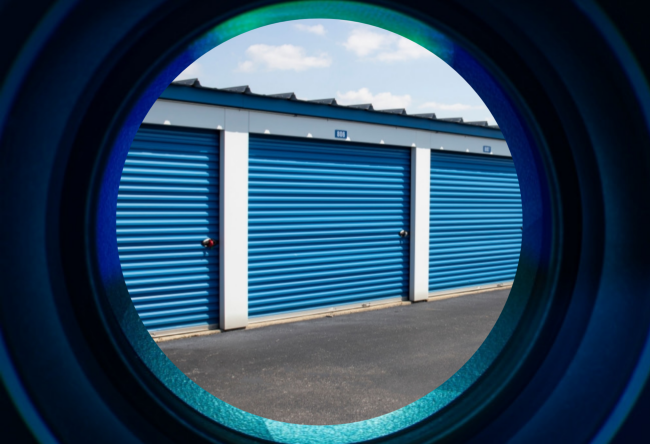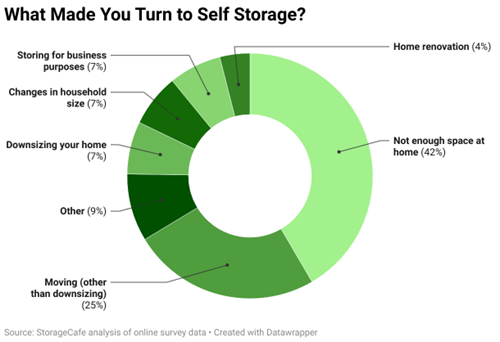
The self-storage market is growing, and it’s creating exciting opportunities for independent operators. At the same time, property risks are growing, too. Self-storage operators can protect their business and fuel their growth by offering insurance for tenants.
The Size of the Self-Storage Market
Mordor Intelligence says the self-storage market is currently valued at $58.26 billion, and it’s expected to grow to $72.15 billion by 2028.
According to the Self-Storage Almanac 2023, there are 51,206 self-storage facilities in the U.S. Some of these facilities are owned by large companies, with Public Storage, Extra Space Storage, U-Haul, CubeSmart, National Storage Affiliates Trust and Life Storage making up the six biggest operators. However, CHRON says that approximately 80% of self-storage businesses are independently owned and operated.
Self-Storage Usage in the U.S.
The market is huge because self-storage is a popular solution for many families and businesses. Storage Cafe says 21% of Americans already use self-storage, and 15% plan to do so in the future. Millennials surpass Gen Xers in terms of storage utilization for the first time in four years, and now comprise a quarter of all storage renters.
A Storage Café survey found the growing demand for self-storage is driven by a shortage of home space, with 42% of respondents stating this as their primary reason for renting self-storage. Apartments have in fact shrunk by 5.3% over the last decade. The surge in remote work, which rose from 5.7% in 2019 to 17.9% in 2021, is further straining home environments.

However, self-storage usage rates vary significantly by region. The Self-Storage Demand Study found that 51% of self-storage users are in suburban areas, 36% are in urban areas and 12% are in rural areas.
Furthermore, some cities have more self-storage space than others. Storage Cafe says that the Dallas-Fort Worth-Arlington areas has the highest amount of self-storage space, with 76.3 million square feet of rentable self-storage space. However, Reno, Nevada, has a higher saturation of self-storage compared to the population size, with 17.2 square feet per capita. For comparison, Dallas-Fort Worth-Arlington only has 10.7 square feet per capita.
Storage Cafe also found that 39% of self-storage renters keep their unit for more than a year, 16% keep their unit for seven to 12 months, 33% keep it for two to six months and 12% keep it for just a year. Neighbor puts the average self-storage rental duration at 14 months.
The differences in rental length are likely related to the differences in usage – someone who’s using self-storage because they’re moving will only need it for a short period of time, but someone who’s using self-storage because they don’t have enough space at their home or business might need storage for a much longer period. According to Storage Cafe, while 42% of self-storage renters need storage because they lack space at home and 25% are moving, 7% of renters use self-storage for business purposes.
Self-Storage Unit Size and Rates
The Self-Storage Demand Study found that the 10×10 unit size is the most popular, representing 24% of all units. The second most popular size is the 10×5 unit, representing 20% of all units. The average monthly rental costs varies based on the unit size, with the average cost for a 10×10 unit being $122, according to Storage Cafe, and the average cost for a 10×5 unit being $76.
Overall, Storage Cafe says the average month rental rate for a unit of any size is $140. However, there are also considerable regional differences. San Rafael, California, has the most expensive self-storage rates, with a unit costing $299 on average. In Bardstown, Kentucky, tenants only pay an average of $50.
Self-Storage Insurance
According to Inside Self-Storage, the five most common causes of self-storage property damage are weather, water, fire, vehicle collisions and crime.
Self-storage units provide an incredibly useful service by giving individuals, families and business owners a place to store items. However, when property damage occurs, those valuable items could be destroyed. A thief could steal cherished family heirlooms, or a fire could destroy critical business documents, or a truck could crash into furniture meant for a new home – there are countless nightmare scenarios.
To mitigate these risks, the Insurance Information Institute also recommends that tenants look for self-storage facilities that offer insurance. However, tenant insurance isn’t just a good idea for renters. It’s also a smart risk management strategy for facility operators. Inside Self-Storage recommends offering tenants insurance as a way to mitigate risks because having a high percentage of covered tenants reduces the risk of a lawsuit against the facility. It makes sense. If a tenant’s belongings are destroyed, they’re going to look for a way to be made whole again. If they have self-storage insurance, the easiest option is to file a claim. If they don’t have coverage, their only option may be to file a lawsuit against the company.
According to Move.org, most large self-storage companies require tenants to carry insurance. That’s smart, but some companies simply tell renters to find coverage on their own. Some renters may end up with inadequate coverage or fail to secure it entirely. When self-storage companies incorporate third-party coverage into their services, they can help tenants get the coverage they need while gaining a piece of the revenue.
Relocation Insurance Group offers storage insurance for many perils, with limits of $50,000 per policy and $10,000 per item. Whether you’re a storage company or a moving company helping a customer with storage, you can count on us to provide robust coverage backed by premier service. Learn more.
